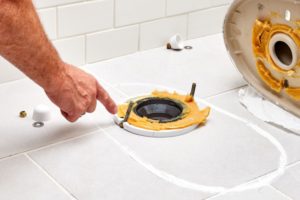Leaks In Toilet Flanges: What Causes Them?
Toilet flanges are commonly damaged, so if your toilet leaks, you might need to replace them. Flanges are metal couplings that connect the toilet and sewer pipe. They secure your toilet to the floor and seal the connection. If either of these wears out or breaks, you will likely experience a leak. Luckily, we’ve got tips for diagnosing and repairing the toilet flange that can help you get back to normal.

There Are 5 Signs That Your Toilet Has A Leak At The Flange
There are several reasons for a leaking toilet, but the most common is a broken, crooked, or faulty flange or wax ring under the toilet. The flange of your toilet may be to blame for your problem, but how can you tell if it is?
Below are the five most common symptoms of toilet flange and wax ring leaks:
- You have a wobbly toilet. Wobbly toilets are a sign that the wax ring and flange beneath them are failing, even if the toilet isn’t leaking yet. These components have the primary purpose of holding the toilet to the floor; if it wobbles, it means they need to be fixed.
- The smell. Gases can escape from a cracked or broken wax ring, causing unpleasant odors in your living space.
- The area where the toilet meets the floor is dripping with water. Water may pool at the base of your toilet if there isn’t any dripping from the tank. It might be the toilet flange.
- There is a springiness or sponginess on the floor around the toilet. The flange may be leaking, which allows toilet water to soak into your subfloor and cause it to be less rigid. As a result, wood rot may occur, posing a safety concern and requiring additional repair work.
- Your toilet’s flooring is deteriorating. Whenever the tile or linoleum surrounding the toilet begins to buckle, rise, or crack, it may indicate that the flange is leaking. If the flooring is soaked, the subfloor will become uneven, and the flooring will come up due to the failure of the adhesive.
A Leaky Toilet Flange Can Cause A Variety Of Problems
It is always possible for a toilet to leak at the base or around the bowl at any time. The toilet simply bolts onto the flange that connects it to the main drain. The wax ring seals the toilet, which will leak if your plumber doesn’t install it properly. In the case of tile work, a homeowner often asks a tile or flooring expert to reinstall the toilet on the flange.
Leaking Water Causes Loose Tiles Around the Base Of The Toilet
During new tile installation, the average floor height can exceed the existing flange by a considerable amount. Tile installers often use two wax rings stacked on top of one another to seal the flange to the toilet. These seals will eventually leak as time passes.
Plumbers can raise the existing flange to the proper height with plastic flange extenders, which bolt onto the existing flange. There is a tendency for most tile installers to be unaware of this repair or not to take the time to perform it properly. Our experience has shown that leaky water can cause loose tiles at the base of the toilet, and we have seen many beautiful new tile floors succumb to ruin due to improper wax ring installation.
Toilets With Leaking Wax Rings Are The Most Common Causes Of Water Leaks Near The Base
Toilets that rock or have become loose from their flanges will leak. It is also possible that uneven tiles can cause a rocking toilet. The plumber should always conduct a dry fit before installing a toilet without a wax ring to ensure that it is securely fastened to the floor. If there is any movement of the toilet, you may wish to install plastic shims under the base to prevent it from rocking. Any move by a toilet can result in the seal at the wax ring and the flange becoming damaged. It can damage flooring, loosen tiles, or even cause sewage spills under raised floors if you ignore water leakage for a time around a toilet.
You May Not See The Leak Under The House If The Flange Is Above A Raised Floor
These types of leaks can cause significant damage to the wood structure and subflooring. It is even possible for them to damage floor joists that support the floor above the ground. It is often necessary to rebuild the flooring and subflooring before repairing a leaky toilet flange.
How to Repair a Toilet Flange
The flange of your toilet should be replaced every six to seven years if you want to ensure that it remains in good condition. After shutting off the water supply and removing the toilet, you’ll need to repair a loose or damaged flange.
After removing the old flange and wax ring, you should clean out any debris that may interfere with the operation of the flange. Once you install the wax ring and flange, reset and reattach the toilet. Finally, turn the water on to check for leaks.
Sometimes, the bolts that hold the toilet in place become rusty, and the nuts are difficult to remove. In this case, remove and replace the rusty bolts using a hacksaw or reciprocating saw.
We Can Repair Any Toilet Flange Leak For You
If water seeps in and damages the plywood under an adequately installed tile, you can remove the plywood without removing the tile and then start rebuilding underneath the raised floor. In addition to this repair, you can also repair plywood flooring affected by a toilet flange leak on the second floor. It is possible to replace the damaged plywood subfloor without causing any damage to the existing tile by accessing the area through the downstairs ceiling.
Plumbing Services for Toilet Flange Leaks
To avoid unpleasant and costly consequences, later on, you should act now to prevent toilet leaks. The entry of bacteria-laden water and sewer gas into your home can cause damage to your home and even pose health and safety concerns. If you need help, Gibber Services is always here for you. Feel free to call us at 901-422-1258 and request a job estimate.








